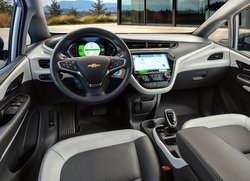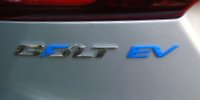Smooth, Affordable EV Driving—For 200 Miles!
The 2017 Chevrolet Bolt is one of the most significant cars of the year. That’s a given. But that significance won’t do you much good when you’re trying to take a corner at well-above the posted speed or doing emergency braking to avoid a bicyclist who’s swerved into the car lane.

That’s what we learned on Clean Fleet Report’s first drive of the new Bolt. It is a significant car not just because it’s winning awards, but because it works in the real world. Like almost every electric car, the Bolt is fast off the line. However, Chevy engineers have tuned the electric motor so you can access the high torque throughout a typical drive. A boost is available whenever you need it from the 200 horsepower (150 kW) electric drive unit. The 266 pounds-feet of torque is available from the moment you hit the accelerator until the power runs out somewhere beyond the speed limit.
The Bolt easily passes the daily drive test. It takes off from a stop sign or light like the proverbial electric jackrabbit, zips onto the freeway and up to speed as well as any car in its class and can take you into the passing lane and around that ICE-engined slowpoke like a turbocharged sporty car.
The Big News Is Inside

While the on-road performance of the Bolt is impressive, it is what EV enthusiasts have come to expect. Where the 2017 Chevrolet Bolt surprises is inside. The numbers tell the story. The Bolt cabin is the equivalent of what you’d expect in the midsize car (like the Malibu) while the exterior dimensions are closer to a compact (like the Cruze). That translates into plenty of elbow and headroom (front and rear) while still presenting a maneuverable, easy-to-park car.
Then the Bolt adds a hatchback, again taking the space gained from the less hardware-intensive electric car design to give a surprising amount of storage area in the rear (56.6 cubic feet with the rear seats folded down). Taking advantage of the current shift to crossovers and SUVs, Chevy is pointing out the Bolt’s crossover-like dimensions and capabilities.
I test drove the base LT model, which comes well-equipped with technology like Apple CarPlay and Android Auto, and equipment such as air conditioning and power mirrors and windows. The Premier upgrade bumps the cloth seats to leather and ladles on even more technology such as blind zone alert, rear park assist, rear cross traffic alert, forward collision alert, lane keep assist and low-speed automatic braking with pedestrian braking either as standard features or options.
Then There’s How Far You Can Go

The big news with the Bolt is its range. The 2017 Chevrolet Bolt is the first affordable electric car to break through the 200-mile range barrier. My short drive didn’t test the car’s range, but my seat-mate was Steve Schaefer, a regular Clean Fleet Report contributor who just passed the 1,000-mile point on his new Bolt. A veteran of many EV drives, Steve remarked that the Bolt takes electric car use to new levels with the range. He said his Bolt is getting more use because he can make so many more trips without having to stress about finding charging to make it home.
Chevy touts the Bolt’s EPA-certified 238-mile range as its potential, but Steve and others have seen 200 miles or slightly under as a more realistic real-world range. As is often noted—and the Bolt even has a screen on its center console display that can give you technical detail—temperature, terrain and driving technique will affect the range dramatically. Never has “your mileage may vary” had a more poignant resonance than when applied to EV driving. With the Bolt, range anxiety fades to a relatively minor concern.
Key Option

GM has kept Bolt ordering pretty simple. Both the LT and Premium trims have a solid list of standard equipment and free-standing options are few. In fact, only one option stands alone at both levels, but is worth consideration—DC fast-charging capability. It’s a $750 option, but a valuable one if you expect to take the Bolt on any long-distance drives. It can deliver 90 miles of range in a half hour.
The LT version of the Bolt starts at $37,495, including destination and freight charges. GM representatives said that with “every option box checked’ the Bolt would not cost more than $43,000. Of course, federal, state and local incentives can bring that price down significantly.
Back on the Road

Back to the drive. Bolt engineers told me the center of gravity on the car was even lower than Volt since the 960-pound, 60 kWh lithium-ion battery pack lies beneath the floorboard. On my drive, that weight kept the Bolt planted to the road. The engineers said they took the time to make sure the Bolt would “drive like a normal ICE (internal combustion engine) car.” Out on the mountain road, the evidence was there. The Bolt responded to every input and didn’t hesitate to charge through the curves.
One feature I experimented with and came away quite impressed was the two-mode transmission. You have the choice of Drive or Low. Unlike a conventional transmission, low is not a low-speed gearing, but in this case is an aggressive regen mode that allows you to drive essentially with one pedal—the accelerator. Lift, and the car immediately slows and will come to a stop. Steve added that he used Low regularly in commuting traffic.
We’ll Be Back

While the time with the engineers and designers was very valuable, this brief drive didn’t really tell us what it would be like to spend a week—or longer—in the 2017 Chevrolet Bolt. It whetted our appetite, and we can’t wait to spend more time in the EV. Steve will be adding his own version of life with the Bolt, so expect a steady stream of news about this break-through car.
Related Stories You Might Enjoy:
News: Bill Mattos, Owner of One of the First Bolts
Buyer’s Guide: Tesla Model 3 or Chevy Bolt
News: 2017 Chevrolet Bolt EV Specs
Disclosure:
Clean Fleet Report is loaned free test vehicles from automakers to evaluate, typically for a week at a time. Our road tests are based on this one-week drive of a new vehicle. Because of this we don’t address issues such as long-term reliability or total cost of ownership. In addition we are often invited to manufacturer events highlighting new vehicles or technology. As part of these events we may be offered free transportation, lodging or meals. We do our best to present our unvarnished evaluations of vehicles and news irrespective of these inducements.
Our focus is on vehicles that offer the best fuel economy in their class. We also feature those that are among the top mpg vehicles in their class. In addition, we aim to offer reviews and news on advanced technology and the alternative fuel vehicle market. We welcome any feedback from vehicle owners and are dedicated to providing a forum for alternative viewpoints. Please let us know your views at publisher@cleanfleetreport.com.

The Bolt certainly does open a new era providing the first consumer priced, significant range EV. All the positive things said about it in the article make total sense to me except one. This is not a true midsize and I would definitely not compare it to a Malibu. Midsize cars are defined as 110 to 119 cu ft and the Bolt just squeaks in at 111 cu ft. It has less rear shoulder and hip room than other PHEVs including the Volt, Sonata, Fusion Energi, and the e-tron. It has a significantly larger cargo area than any of these, but a better comparison is the CMAX Energi which has 19.2 cu ft cargo (vs 16.9 cu ft for the Bolt) and 118.9 cu ft total (vs 111 cu ft for the Bolt).
My point is that the Bolt is a great car creating a totally new class offering for consumers (hats off to GM for that), but it is NOT a solid midsize yet and should not be billed as such. I spent a good bit of time in all the seats of the Bolt at the Detroit auto show and it is bigger than a Leaf for sure, but it is still quite compact and cozy. I am still waiting for an EV, or even a PHEV, at a consumer price that is a real midsize sedan or SUV.
@Ed,
Your precise measurements and comments are spot on, although we are seeing a little squishiness around some of the sector dimensions. Forgive me if my excitement about my first drive in the Bolt got the better of me. I do think the hatch and storage flexibility do give it more flexibiliity than a conventional midsize sedan, as you noted, and that is significant. In comparison with the C-Max Energi (now departed), the under-floor battery design renders the Bolt much more capable in my opinion. Thanks for your comments. –ed.